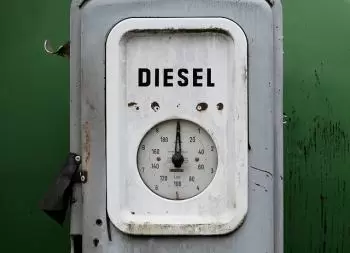
Diesel, also known as gasoil, is a fuel derived from crude oil obtained through refining processes.
This liquid hydrocarbon is widely used to fuel internal combustion engines in vehicles, generate electricity and provide energy for heating. Its main physical and chemical characteristics and applications are detailed below.
Composition and chemical properties of diesel
Diesel fuel is a complex mixture of aliphatic hydrocarbons, including cyclic and paraffinic compounds, containing between 13 and 18 carbon atoms. This composition gives it a higher density and a higher flash point than gasoline, making it less flammable and therefore safer to handle and store.
The sulphur content in diesel has historically been an environmental issue. However, modern regulations, such as EN 590 in Europe, have drastically reduced its concentration to less than 10 mg/kg. This limit is crucial to minimise emissions of sulphur dioxide (SO₂) and particulate matter during combustion. Despite this, sulphur also performs a lubricating function, which has forced manufacturers to add additives to compensate for its removal.
Production and obtaining of diesel
 Diesel is produced by several methods, including:
Diesel is produced by several methods, including:
-
Destilación fraccionada: Este es el proceso clásico, en el cual el petróleo crudo se calienta en una torre de fraccionamiento. El diésel se extrae en un rango de temperaturas alrededor de los 350 °C. La calidad del combustible depende directamente de las características del crudo y de la precisión del proceso de refinación.
-
Craqueo catalítico: Este método implica la fragmentación de hidrocarburos pesados en moléculas más ligeras mediante el uso de catalizadores. Es una técnica eficiente que permite optimizar la producción de diésel, pero a un costo energético y económico elevado.
-
Síntesis GTL (Gas to Liquid): El proceso GTL convierte gas natural (metano) en hidrocarburos líquidos mediante el uso de un catalizador, produciendo un diésel de alta pureza y sin contenido de azufre. Este tipo de diésel reduce significativamente las emisiones de partículas y óxidos de nitrógeno (NOx). Además, empresas como Shell han integrado GTL en combustibles premium como el V-Power.
-
Diésel renovable: Conocido como biodiésel, se produce a partir de biomasa (aceites vegetales, residuos agrícolas, etc.) mediante un proceso de transesterificación. Aunque se considera más sostenible, presenta desafíos en términos de almacenamiento y mezcla con el diésel fósil.
Tipos de diésel y sus aplicaciones
Diésel automotriz
 El diésel es ampliamente usado en motores de ciclo Diesel, donde se inyecta directamente en la cámara de combustión.
El diésel es ampliamente usado en motores de ciclo Diesel, donde se inyecta directamente en la cámara de combustión.
Para cumplir con las normativas europeas, como la EN 590, el diésel debe tener propiedades específicas, como un número mínimo de cetano de 51 y un bajo contenido de azufre. Estas características aseguran una combustión más eficiente y menos contaminante.
Diésel para combustión estacionaria
Este tipo de diésel, utilizado en calderas y generadores, tiene especificaciones menos estrictas. Permite un mayor contenido de azufre (hasta el 0.1%) y no exige un punto de destilación máximo (T95). Esto reduce los costos de producción, pero también implica un mayor impacto ambiental.
Diésel marino
Los motores diésel empleados en barcos utilizan un combustible con un punto de ebullición alto y un contenido de azufre más elevado.
La norma ISO 8217 regula este tipo de combustibles, aunque se espera que futuras normativas limiten aún más sus emisiones, especialmente en regiones como el Mediterráneo.
Propiedades físicas del diésel
Apariencia y color
El diésel debe ser claro y libre de impurezas visibles. Su color varía según el proceso de producción y los aditivos utilizados, aunque tonalidades opalescentes pueden indicar contaminación o degradación del producto.
Densidad y valor calorífico
La densidad del diésel es de aproximadamente 835 kg/m³, lo que le otorga un mayor rendimiento energético por volumen en comparación con la gasolina. Su valor calorífico se sitúa alrededor de 40.9 MJ/kg (10,200 kcal/kg), haciéndolo un combustible eficiente para aplicaciones de largo alcance.
Propiedades a bajas temperaturas
A key characteristic of diesel is its performance in cold climates. At low temperatures, paraffin crystals can form, clogging fuel filters. Therefore, EN 590 sets out requirements to ensure diesel's fluidity in winter, including Arctic variants that operate down to -21°C.
Cetane number
The cetane number measures how easily diesel can ignite in an engine. Higher values (minimum 51 according to EN 590) indicate faster and more efficient combustion, which improves performance and reduces polluting emissions.
Environmental impact and pollution
Diesel generates various polluting emissions, including:
- Carbon dioxide (CO₂): Main greenhouse gas produced during combustion.
- Nitrogen oxides (NOx): Responsible for the formation of smog and acid rain.
- Fine particulate matter (PM): Emitted in greater quantities than in gasoline engines, which represents a risk to respiratory health.
To mitigate these effects, modern fuels include additives and are combined with biodiesel to reduce emissions. However, the presence of biodiesel also increases the risk of bacterial contamination, as this component attracts water, facilitating the growth of microorganisms in storage tanks.
Diesel pollution problems
Diesel, although efficient as a fuel, poses significant environmental pollution and public health problems. One of the main pollutants associated with diesel use is nitrogen dioxide (NO₂), a toxic gas that contributes to smog and can cause serious respiratory problems. In addition, diesel engines emit fine particulate matter (PM2.5 and PM10), which penetrate deep into the lungs and cardiovascular system, increasing the risk of diseases such as asthma, lung cancer and heart problems.
Another area of concern is the sulphur content in diesel fuel. Although modern regulations, such as EN 590 in Europe, have drastically reduced sulphur content to less than 10 mg/kg, its historical presence contributed to acid rain and soil and water pollution.
The use of biodiesel in blends also presents other drawbacks, such as bacterial contamination in tanks, which can lead to storage problems and fuel degradation.
Urban areas, where traffic is dense, are especially vulnerable, and cleaner alternatives such as electrification and the use of synthetic fuels are being sought to mitigate these problems.